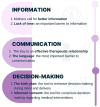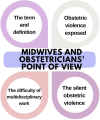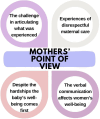Obstetric violence: perspectives from mothers, midwives, and obstetricians
- PMID: 40538912
- PMCID: PMC12176849
- DOI: 10.3389/fgwh.2025.1609632
Obstetric violence: perspectives from mothers, midwives, and obstetricians
Abstract
Background: According to the World Health Organization (WHO), the majority of the 140 million annual births occur without complications. Women desire a positive birth experience based on respectful care, clear information, and emotional support, which enables them to make informed decisions and maintain control over their reproductive process. However, many women experience disrespectful or abusive treatment during obstetric care, with lasting consequences for both their physical and mental health. This study explores the factors that influence respectful maternal care and the phenomenon of obstetric violence, as perceived by mothers, midwives, and obstetricians.
Methodology: A qualitative study using a phenomenological approach was conducted in eight public and private hospitals in the Girona Health Region (Catalonia, Spain) between 2021 and 2022. In-depth interviews were conducted with eight mothers and eight healthcare professionals (midwives and obstetricians) selected through purposive sampling. The interviews were transcribed verbatim and analysed using thematic analysis to identify meaningful units and key themes.
Results: The narratives collected allowed for the identification of key elements of non-respectful maternal care. A lack of information during pregnancy and childbirth emerged as a central concern for both mothers and professionals, affecting their sense of control and satisfaction. Poor communication with healthcare providers, particularly with anaesthesiologists and obstetricians, was perceived as a barrier to quality care. Mothers reported experiences of disrespect, the absence of informed consent for procedures such as episiotomies, and paternalistic treatment. Obstetricians showed resistance to the term "obstetric violence," while midwives recognized it as practices and attitudes that negatively affect the maternal experience.
Conclusions: The discrepancy between professional perspectives and mothers' experiences highlights the urgent need for transformation in obstetric care. It is crucial to promote a care model based on evidence, effective communication, and respect for women's rights. Incorporating a gender perspective into healthcare training and strengthening public policies to ensure respectful obstetric care are essential measures to improve the quality of care and prevent obstetric violence.
Keywords: health care quality; informed consent; maternal health; midwifery; obstetric violence; patient-provider communication; pregnancy; qualitative research.
© 2025 Reyes-Amargant, Fuentes-Pumarola, Roqueta-Vall-llosera, Garre-Olmo, Ballester-Ferrando and Rascón-Hernán.
Conflict of interest statement
The authors declare that the research was conducted in the absence of any commercial or financial relationships that could be construed as a potential conflict of interest.
Figures




Similar articles
-
Factors that influence the provision of intrapartum and postnatal care by skilled birth attendants in low- and middle-income countries: a qualitative evidence synthesis.Cochrane Database Syst Rev. 2017 Nov 17;11(11):CD011558. doi: 10.1002/14651858.CD011558.pub2. Cochrane Database Syst Rev. 2017. PMID: 29148566 Free PMC article.
-
Home treatment for mental health problems: a systematic review.Health Technol Assess. 2001;5(15):1-139. doi: 10.3310/hta5150. Health Technol Assess. 2001. PMID: 11532236
-
Barriers to informed consent in obstetric care during childbirth from practitioner's perspective: a qualitative study.BMJ Open. 2025 Jun 19;15(6):e101591. doi: 10.1136/bmjopen-2025-101591. BMJ Open. 2025. PMID: 40537228 Free PMC article.
-
"It's a tool, it's got hardships": a qualitative study of patient experience of colonoscopy and implications for trauma-informed care.Therap Adv Gastroenterol. 2025 Jun 21;18:17562848251346250. doi: 10.1177/17562848251346250. eCollection 2025. Therap Adv Gastroenterol. 2025. PMID: 40547252 Free PMC article.
-
Non-clinical interventions for reducing unnecessary caesarean section.Cochrane Database Syst Rev. 2018 Sep 28;9(9):CD005528. doi: 10.1002/14651858.CD005528.pub3. Cochrane Database Syst Rev. 2018. PMID: 30264405 Free PMC article.
References
-
- World Health Organization. Intrapartum care for a positive childbirth experience WHO recommendations. Geneva (2018). p. 210. Available at: https://www.who.int/publications/i/item/9789241550215 (Accessed February 04, 2025). - PubMed
-
- Zampas C, Amin A, O’Hanlon L, Bjerregaard A, Mehrtash H, Khosla R, et al. Operationalizing a human rights-based approach to address mistreatment against women during childbirth. Health Hum Rights. (2020) 22(1):251–64. Available at: https://www.ncbi.nlm.nih.gov/pmc/articles/PMC7348458/ (Accessed March 1, 2025). - PMC - PubMed
LinkOut - more resources
Full Text Sources

